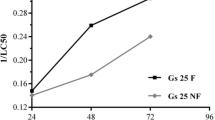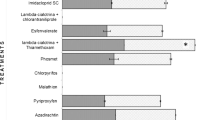Abstract
The toxicity of methoxychlor, determined in acute and chronic studies using larval, juvenile, and adult stages of the Dungeness crab, Cancer magister Dana, was inversely related to the age of the crabs after hatching and increased with the length of exposure. The 96-h LC50's for zoeae, juveniles, and adults were 0.42, 5.10, and 130 μg/l, respectively. Levels causing decreased survival of these same stages during exposures of more than 60 days were 0.05, 0.40, and 4.0 μg/l, respectively. Hatching of eggs was not adversely affected by methoxychlor concentrations up to 10 μg/l, and molting from prezoeae to zoeae was reduced only 30% from controls at the latter exposure concentration. Methoxychlor concentrations of 0.05 and 4.0 μg/l delayed motting of larval and juvenile crabs, respectively, and this delay was as much as 10 days for the juveniles. Sensitivity of adult and juvenile crabs to methoxychlor increased during ecdysis. In uptake experiments, juvenile crabs concentrated methoxychlor more rapidly than did adults. Juveniles exposed to 2.0 μg/l of methoxychlor and adults exposed to 1.8 and 7.5 μg/l had whole body methoxychlor concentrations after 12 days of 0.88, 0.10, and 0.51 mg/kg, respectively. Loss of the pesticide from adult crabs was rapid, and was 95% complete after 15 days of depuration. Concentrations of methoxychlor in individual tissues were found to be highest in the exoskeleton, gill, and hepatopancreas, in declining order, with less than a two-fold difference among these tissues. About 81% of the methoxychlor measured in whole body samples was associated with the exoskeleton, but it is not known whether or not the pesticide was transported through the culticle to internal tissues.
Similar content being viewed by others
Literature Cited
American Public Health Association, American Water Works Association and Water Pollution Control Federation: Standard methods for the examination of water and wastewater, 13th ed. 874 pp. Washington, D.C.: American Public Health Ass. 1971
Bedford, J.W., E.W. Roelofs and M.J. Zabik: The freshwater mussel as a biological monitor of pesticide concentrations in a lotic environment. Limnol. Oceanogr. 13, 118–126 (1968)
Dookhout, C.G., A.J. Wilson, Jr., T.W. Duke and J.I. Lowe: Effects of mirex on the larval development of two crabs. Wat. Air Soil Pollut. 1, 165–180 (1972)
Buchanan, D.V., R.E. Millemann and N.E. Stewart: Effects of the insecticide Sevin on various stages of the Dungeness crab, Cancer magister. J. Fish. Res. Bd Can. 27, 93–104 (1970)
—, M.J. Myers and R.S. Caldwell: Improved flowing water apparatus for the culture of brachyuran crab larvae. J. Fish. Res. Bd Can. 32, 1880–1883 (1975)
Caldwell, R.S., D.A. Armstrong, D.V. Buchanan, M.H. Mallon and R.E. Millemann: Toxicity of the fungicide captan to the Dungeness crab, Cancer magister, Dana. (In preparation)
Costlow, J.D., Jr.: The effect of eyestalk extirpation on larval development of the mud crab, Rithropanopeus harrisii (Gould). Gen. comp. Endocr. 7, 255–274 (1966)
Duke, T.W., J.I. Lowe and A.J. Wilson, Jr.: A polychlorinated biphenyl (Aroclor 1254® in the water, sediment, and biota of Escambia Bay, Florida. Bull. envir. Contam. Toxicol. 5, 171–180 (1970)
Eisler, R.: Tissue changes in puffers exposed to methoxychlor and methyl parathion. Tech. Pap. Bur. Sport Fish. Wildl., Wash. 17, 1–15 (1967)
—: Acute toxicities of insecticides to marine decapod crustaceans. Crustaceana 16, 302–310 (1969)
Epifanio, C.E.: Effects of dieldrin in seawater on the development of two species of crab larvae, Leptodius floridanus and Panopeus herbstii. Mar. Biol. 11, 356–362 (1971)
Johnson, B.T. and J.O. Kennedy: Biomagnification of p,p'-DDT and methoxychlor by bacteria. Appl. Microbiol. 26, 66–71 (1973)
Kapoor, I.P., R.L. Metcalf, R.F. Nystron and G.K. Sangha: Comparative metabolism of methoxychlor, methiochlor, and DDT in mouse, insects, and in a model ecosystem. J. agric. Fd Chem. 18, 1145–1152 (1970)
Kennedy, H.D., L.L. Eller and D.F. Walsh: Chronic effects of methoxychlor on bluegills and aquatic invertebrates. Tech. Pap. Bur. Sport Fish. Wildl., Wash. 53, 1–18 (1970)
Lockwood, A.P.M.: Aspects of the physiology of Crustacea, 328 pp. San Francisco: W.H. Freeman 1967
Manske, D.D. and P.E. Corneliussen: Pesticide residues in total diet samples VII. Pestic. Monit. J. 8, 110–124 (1974)
Merna, J.W., M.E. Bender and J.R. Novy: The effects of methoxychlor on fishes. I. Acute toxicity and breakdown studies. Trans. Am. Fish. Soc. 101, 298–301 (1972)
Modin, J.C.: Chlorinated hydrocarbon pesticides in California bays and estuaries. Pestic. Monit. J. 3, 1–7 (1969)
Nimmo, D.R., R.R. Blackman, A.J. Wilson, Jr. and J. Forester: Toxicity and distribution of Aroclor® 1254 in the pink shrimp Penaeus duorarum. Mar. Biol. 11, 191–197 (1971)
—, A.J. Wilson, Jr. and R.R. Blackman: Localization of DDT in the body organs of pink and white shrimp. Bull. envir. Contam. Toxicol. 5, 333–341 (1970)
O'Brien, R.D.: Insecticides: action and metabolism, 332 pp. New York: Academic Press 1967
Passano, L.M.: Molting and its control. In: The physiology of crustacea. Vol. 1. Metabolism and growth, pp 473–536. Ed. by T.H. Waterman. New York: Academic Press 1960
Poole, R.L.: Preliminary results of the age and growth study of the market crab (Cancer magister) in California: the age and growth of Cancer magister in Bodega Bay. In: Proceedings of the Symposium on Crustacea held at Ernakulam, Part II. pp 553–567. Marine Biological Association of India. Bangalore: Bangalore Press 1967
— and M. Willis: Effects of some pesticides on larvae on the market crab, Cancer magister, and the red crab, Cancer productus, and a bioassay of industrial wastes with crab larvae, Manuscr. Rep. Calif. Dep. Fish Game mar. Resour. Reg. 70-15, 1–19 (1970)
Reinbold, K.A., I.P. Kapoor, W.F. Childers, W.N. Bruce and R.L. Metcalf: Comparative uptake and biodegradability of DDT and methoxychlor by aquatic organisms. Bull. Ill. St. nat. Hist. Surv. 30, 405–415 (1971)
Wildish, D.J. and V. Zitko: Uptake of polychlorinated biphenyls from sea water by Gammarus oceanicus. Mar. Biol. 9, 213–218 (1971)
Author information
Authors and Affiliations
Additional information
Communicated by J.S. Pearse, Santa Cruz
Technical Paper No. 4133, Oregon Agricultural Experiment Station.
Rights and permissions
About this article
Cite this article
Armstrong, D.A., Buchanan, D.V., Mallon, M.H. et al. Toxicity of the insecticide methoxychlor to the Dungeness crab Cancer magister . Mar. Biol. 38, 239–252 (1976). https://doi.org/10.1007/BF00388937
Accepted:
Issue Date:
DOI: https://doi.org/10.1007/BF00388937




